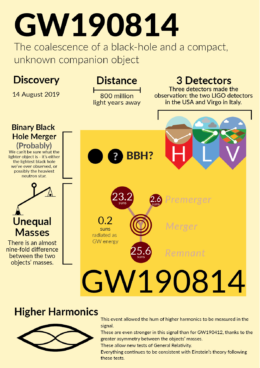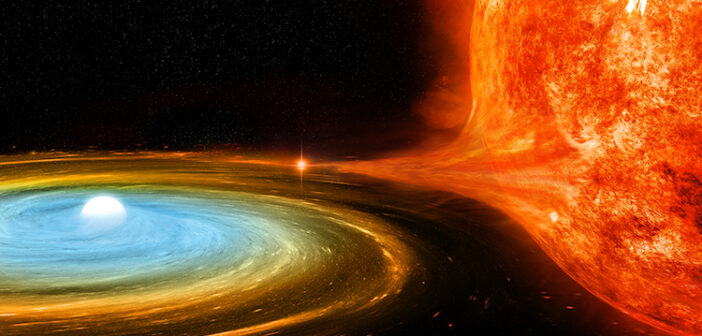Extremely compact stellar remnants made of a mixture of normal matter and dark matter could explain a variety of puzzling observations, but it’s not clear exactly how these objects might form. Now, researchers have modeled a potential formation pathway and proposed a way to track them down.
Where Dark Matter and Normal Matter Meet

An infographic describing the gravitational wave event GW190814, which contained a 2.50–2.67-solar-mass object of unknown type. Click to enlarge. [LIGO Scientific Collaboration]
A team led by Ho-Sang Chan (The Chinese University of Hong Kong) has proposed that neutron stars containing a small amount of dark matter might form through a circuitous route. First, a low- to intermediate-mass star composed of normal and dark matter evolves to become a white dwarf: an Earth-sized sphere containing roughly the mass of the Sun. If this white dwarf has a giant stellar companion, it can steal some of the companion’s gas and become so massive that it collapses under its own gravity. Usually, this would lead to a supernova explosion, but under certain conditions, the white dwarf might shrink down to become a neutron star instead.
Chan and collaborators suggest that observing these events, called accretion-induced collapse, might yield a way to study the properties of these unusual neutron stars and of dark matter itself.
Conceptualizing Collapse
While the visible-light signature of a white dwarf collapsing to form a neutron star would be faint, Chan and collaborators have suggested that we might be able to track them down via their gravitational wave emission. The team used two-dimensional fluid dynamics simulations to study how a dark-matter-containing white dwarf would collapse into a neutron star and estimated the gravitational waves that would be emitted in the collapse.
The team set the mass of their dark matter particles to a little more than a tenth of the mass of a proton, and they considered white dwarfs containing 1–20% dark matter by mass. Additionally, they considered different rotation profiles for the stars: rigid rotation (like a spinning top) and Keplerian rotation (like planets in the solar system, the velocity is highest near the center and lowest farther out).
Observational Prospects

Normalized gravitational wave strain (related to the wave amplitude) from the collapse of Kepler-rotating white dwarfs containing, from top to bottom, 0%, 1%, 5%, 10%, and 20% dark matter by mass. [Chan et al. 2023]
Hopefully, future gravitational wave observations will yield new information about these theorized neutron stars, potentially illuminating the nature of dark matter.
Citation
“Accretion-induced Collapse of Dark Matter-admixed Rotating White Dwarfs: Dynamics and Gravitational-wave Signals,” Ho-Sang Chan et al 2023 ApJ 945 133. doi:10.3847/1538-4357/acbc1d

